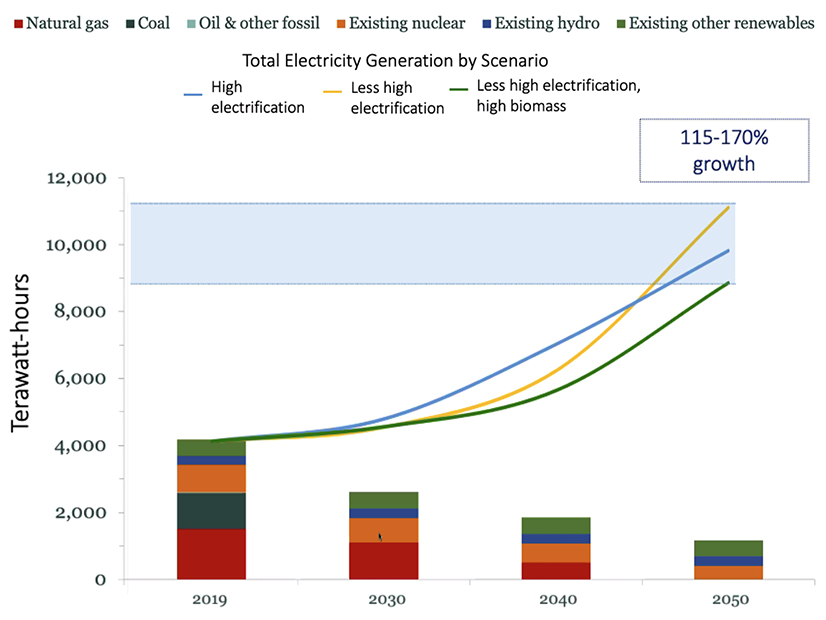
A trio of experts on Monday presented various perspectives on reaching net-zero emissions: a macro view of the whole country; a micro view of one city; and the third on policies at both the state and federal levels.
Expanding the supply of clean electricity is a linchpin in all net-zero paths, Jesse Jenkins, assistant professor of mechanical and aerospace engineering at Princeton University, said at the National Association of Regulatory Utility Commissioners’ annual meeting in Louisville, Ky.
“The share of electricity from carbon-free sources roughly doubles from about 37% today to 70 to 85% by 2030 and reaches 98 to 100% by 2050,” Jenkins said.
Princeton’s Andlinger Center for Energy and the Environment in October released the final version of a comprehensive study on reaching net-zero greenhouse gas emissions, which was first published in draft form at the end of last year. (See Net Zero Price Tag: $2.5 Trillion.)
The study looked at five different ways to reach net zero, “not because any of these are favorite pathways or we want to privilege these in particular, but because they help us try to explore some of the different choices and trade-offs that we might have to face,” Jenkins said. The scenarios are high electrification; less-high electrification; high biomass; constrained renewable energy; and 100% renewable energy.
The transformation of the energy sector will require “about a tripling of our high-voltage transmission grid … so we need to finance and mobilize about $2.5 trillion of additional capital in the 2020s alone,” Jenkins said.
The study’s research focused on carbon storage locations outside of the West, and Wyoming Public Service Commissioner Mary Throne “wondered how you identified those locations. Was it pipeline-related?”
The study looked at the largest basins, and there are many locations for geologic storage scattered throughout the country in different locations, Jenkins said.
“One of the key challenges is how much you can inject per well, which then determines the cost of injection, because if you can only inject half as much per well, you have to build twice as many wells at twice the cost,” Jenkins said. “So we focused on creating a supply chain of sites based on geologic estimates of the injectivity rates that could be achieved in different basins.”
LA100
Jaquelin Cochran, director of grid planning and analysis at the National Renewable Energy Laboratory, has been helping Los Angeles and its Department of Water and Power (LADWP) create a first-of-its-kind study, LA100, to analyze potential pathways the city can take to achieve 100% renewable energy.
While LADWP is electrically connected to the rest of the West, it is not a member of CAISO, so it must ensure it is always self-sufficient and supplying local demand for electricity no matter what else is happening in the West, Cochran said. “This makes achieving the 100% renewable energy target especially difficult.”
The study’s layers of detail allowed city planners to see how much new electric demand from electrifying transportation and buildings might be flexible, Cochran said. For example, demand from residential and commercial buildings could remain fairly flat through 2045, with growth offset by improvements to energy efficiency, she said.
“Instead we see that the main cause for growth in peak demand is due to the electric vehicles,” Cochran said. “Today in L.A. peak demand for electricity occurs in the afternoon. In the future the timing could vary based on when the electric vehicle charging takes place, so when we assume more access to workplace charging, the peak demand occurs early afternoon.”
The study also highlighted the public health benefits associated with decreasing the amount of fine particulate matter in the air.
“All scenarios in our study achieve 6 to 8% reduction of fine particulate matter concentrations in the air, mostly because of the adoption of electric vehicles,” Cochran said.
The study forecasts $1.5 billion in public health savings in 2045 alone and “that all communities will share in the benefits of the clean energy transition, most notably because of these health benefits, but also from improving equity and participation,” Cochran said.
Accelerating Decarbonization
Susan Tierney, senior adviser at Analysis Group, provided a policy-oriented view of these pathways and how to bring them to fruition based on her work on the recently released National Academies of Sciences, Engineering and Medicine report, “Accelerating Decarbonization in the United States.”
“In order for this to be a sustainable change, decarbonization has to rely on a much more equitable transition, not just for communities that are moving from a fossil economy, but also for communities that have been really left out of and have borne the brunt of both energy access issues and frontline pollution concerns,” Tierney said.
“One of the things that we identified as being critical to accomplishing decarbonization in an affordable fashion in the long run is to transfer equipment at the end of its useful life to electric stock, and we know for local gas distribution companies, this is going to be very challenging,” Tierney said. “I know that many of you state regulators are looking at this with your different local gas companies to figure out how you can support electrification without leaving some of your poorest gas consumers on the system and bearing more and more cost.”


